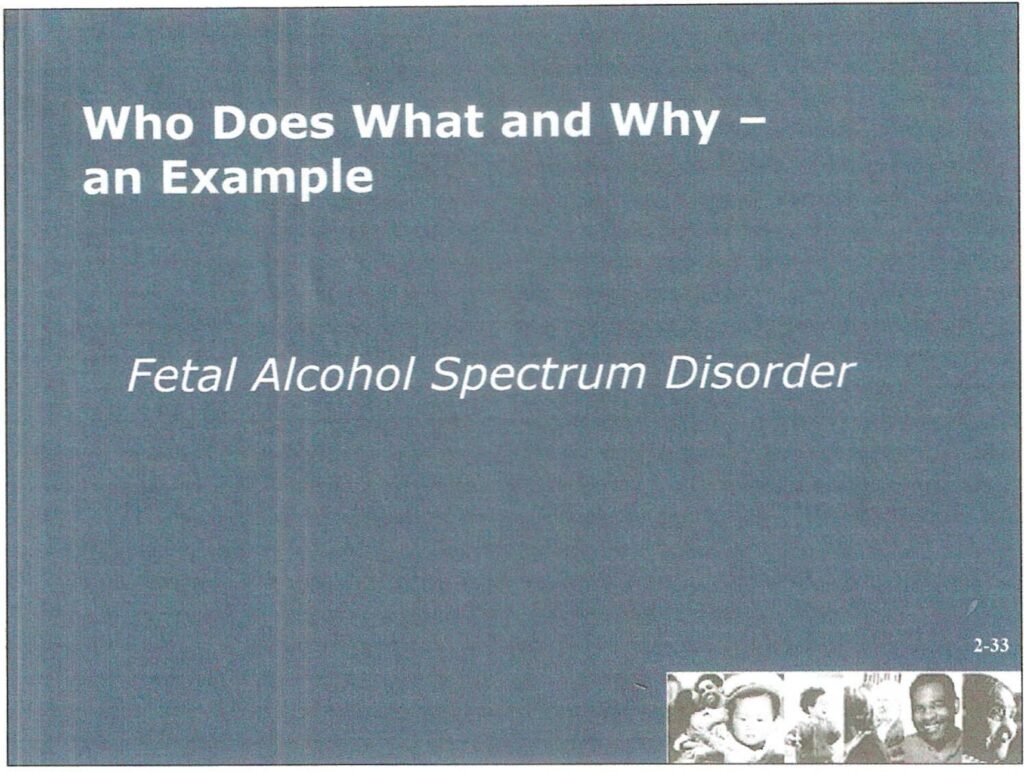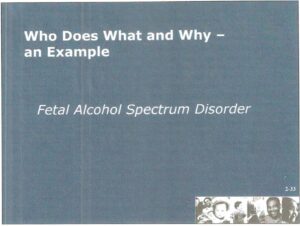Fetal Alcohol Spectrum Disorder

Fetal Alcohol Spectrum Disorder

Fetal Alcohol Spectrum Disorder is an umbrella term used to describe the range of disabilities (and diagnoses) associated with prenatal exposure to alcohol.
Exposure to alcohol before birth can lead to long-term physical, cognitive and developmental disabilities
FASD may include:
- reduced or delayed growth of the baby
- physical birth defects
- developmental learning and behavioral disorders that may not be noticed until months or years after the child’s birth.
Federal, provincial/territorial and local governments share responsibility for: prevention; training; education/awareness; knowledge generation and exchange.
Offer dieting guidelines through Department of Health and Human Services (HAS) and Department of Aquailture (USDA).
AMI BODY MASS Calculator
Fact Sheets Surgeon General’s Healthy
Advice for consumers
Federal Programs and Initiatives
-Canada Prenatal Nutrition Program: expanded in 1999 federal Budget: to allow for a sustained national focus on F ASD and to further improve the health of pregnant women at risk and their babies. This builds on existing programs of provinces, territories, Aboriginal organizations, parent and community groups.
– The Federal Government has been working with provinces and territories on developing a national public awareness and education campaign.
–The Public Health Agency of Canada FASD Initiative: supports prevention; develops public education tools & resources; builds capacity and enhances coordination & collaboration across the country; develops practical tools for community-based programs; and provides leadership and coordination through consultation and other processes for F ASD initiatives
-Health Canada has special initiatives for First Nations on reserve and Inuit.
Provinces and Territories
-Provincial/territorial and local governments are primarily responsible for diagnostic services and support services (except for First Nations on reserve, Inuit and people in federal institutions).
-The western provinces and Yukon have made the most progress regarding awareness, education, .t training and development of resources. For example: The Canada Northwest FASD Partnership is an alliance of the governments of AB, SK, MB, YK and NWT, BC and Nunavut, and has a commitment to develop, promote and coordinate a comprehensive approach to the prevention of FASD.
Intergovernmental and Interdepartmental Strategies
In its 2003 Federal Budget, the Government of Canada committed $320 million over five years for a strategy to improve and expand Early Childhood Development (ECD) programs and services for First Nations and other Aboriginal children. Of this, $15 million annually is identified for work on F ASD.
The Early Childhood Development (ECD) Agreement (September 2000)
- This was established by Canada’s First Ministers (Le. Prime Minister & Premiers) as a new national social priority. It recognized the importance of children’s early years in shaping long-term outcomes. The federal government committed to transfer $2.2 billion over five years to provinces and territories to improve and expand their ECD programs and services. Canada’s First Ministers committed to report regularly on their progress, and to continue to build knowledge and share information with parents, service providers and communities.
- The First Ministers agreed to invest in four key areas of action:
promote healthy pregnancy, birth and infancy; ii) improve parenting and family supports;
strengthen early childhood development, learning and care; and iv) strengthen community supports.
- The initial $300 million in federal funding began to flow to provincial and territorial governments on April 1, 2001 through the Canada Health and Social Transfer (CHST). British Columbia, Alberta, Saskatchewan, Manitoba, Ontario and the Yukon have identified FASD as a priority for action.
ASK what types of groups might be involved. Answers can include: ·health care and allied professional groups
- frontline and community based workers organizations
- voluntary parent / caregiver and community groups and coalitions ·researchers working in the field
- Aboriginal groups
- Industry groups
DISCUSS the roles the groups might play. Roles can include: ·provide a picture of community needs ·provide input and feedback
- provide for advocacy of the issue
- coordinate action at their level
ILLUSTRATE that the voluntary sector and other organizations exist at different levels and thus have multiple opportunities to influence the FASD Initiative.


Just use your name and valid email address – I will never sell or share your email address with anyone. Never. You may unsubscribe anytime. I hate spam just as much as you do.
Regards, Coyalita
Behavioral Health Rehabilitative Specialist & Addiction Counselor
Copyright © 2021-2023 Thresholdlivecoyalita.com All Rights Reserved Privacy Policy – Earnings Disclaimer – Terms of Use – Contact Us




